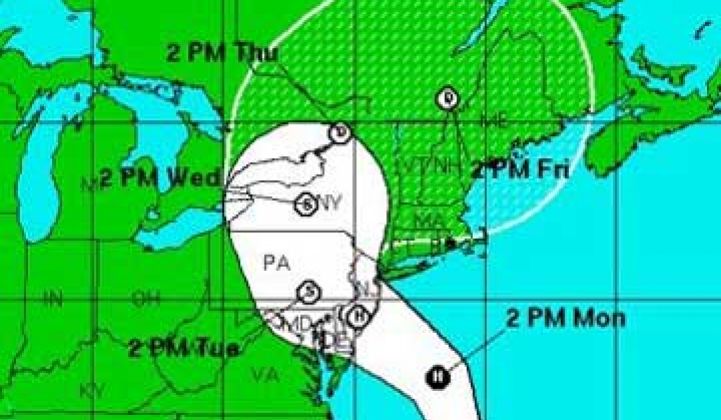By Tuesday morning, more than eight million people were left without power after Hurricane Sandy churned water onto roads, tunnels and into homes and businesses across the East. Substations exploded in New York City. Atlantic City was inundated. Trees went down across Delaware, Pennsylvania and Connecticut.
In New Jersey, the hardest-hit state, about two-thirds of utility customers were without power as of 9 a.m. on Tuesday. With a storm of this magnitude, power outages are unavoidable. Trees will always go down. In New York City, which has the bulk of its system underground, floodwaters put significant portions of ConEd’s grid at risk.
The question for companies and utilities pushing the envelope of technological innovation is how much investment in smart grid can help at a time like this.
As Greentech Media reported on Monday, state-of-the-art outage management systems and self-healing feeders can mitigate damage and limit the spread of power loss to some degree, depending on the damage. But Consolidated Edison, which serves New York City, called the extent of damage “unprecedented.”
Another solution is for utilities to use sophisticated analytics to look forward, rather than just using historical data to inform storm response, especially with the increasing frequency of unprecedented storms.
Far before Sandy was a low-pressure system in the ocean, IBM started thinking of all the data being generated from increasingly sophisticated grid components, such as smart meters and sensors on the grid, and how that data can be maximized for operations.
To study and commercialize applications, IBM just launched a Smarter Energy Research Institute, which will be a collaborative model between different utilities to use data for analytics that are both “predictive and prescriptive,” said Allan Schurr, vice president of Strategy & Development for Energy & Utilities at IBM.
He noted that utilities that are already pushing the envelope are looking at even more advanced techniques. The Institute, referred to as SERI, will bring together IBM Research experts in mathematical sciences, computer science and high-performance computing with engineers from member utilities. The three founding members are Hydro-Quebec (Canada), Alliander (Netherlands) and DTE Energy (U.S.). IBM started by asking utilities which type of predictions they are looking for and came up with five distinct categories.
The first category is outage planning, which includes planned and unplanned work. In the case of maintenance, for example, algorithms can find patterns of heat-based overloading in transformers to help utilities make decisions about when to replace them.
When it comes to outages, predictive analytics can inform crews about where to be staged, or better model how underground or overhead lines respond to environmental factors. For utilities that are investigating distribution automation projects, Schurr said that analytics can help identify how much and where to make the investment.
IBM wouldn’t speculate on how such analytics could have impacted the utilities reeling from Sandy, but analytics that could be used to model weather situations in conjunction with historical data are needed. “We have a 100-year storm every two years now,” New York Governor Andrew Cuomo said after the storm.
At SERI, analytics will also be tested in asset management optimizations. “We’re using more sensory information to target condition-based maintenance more accurately,” said Schurr.
For utilities working with the SERI, findings will be shared, and there are production systems so that members can move the technology from pilot to implementation. The process of collaboration might not completely negate the need for a pilot to test analytics with legacy systems, but “the close collaboration at SERI will take some of the unknowns that accompany a technology that may be proposed and make it more familiar from the beginning,” said Schurr.
The Institute will also have projects in a few additional areas, including integration of renewables and distributed energy, wide-area situational awareness and analytics that will look at demand-side management to better match demand response with localized needs.
Many of these analytics, when commercialized, could be cloud-based, although some, like real-time situational awareness, would likely require server investments.
IBM is hardly the first to see the growing need for sophisticated analytics to crunch the data coming off of smart grid investments. Southern California Edison has a laundry list of partners, including Boeing, General Electric and Space-Time Insight, for a project that will test the interplay of smart grid systems with everything from distributed generation to electric vehicles.
Meter data management companies are also looking beyond simple meter applications into far more sophisticated analytics that can inform operations, customer relations and business processes.
IBM expects to add more utilities to the Institute later this year and into 2013. “The time was right for us to find clients that wanted to push on those envelopes together,” said Schurr. But it is still early days, and while the investment might not pay off in 2013 or even 2014, IBM hopes the focus on data analytics will pay off as sophisticated utilities become the norm instead of the exception. “We see this as a very long-term opportunity.”
